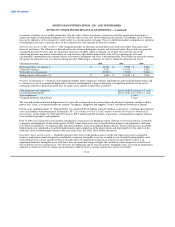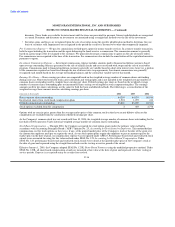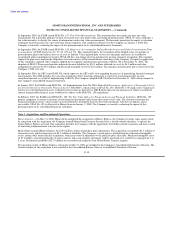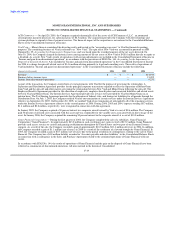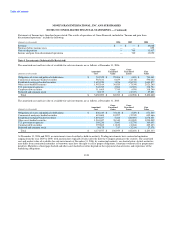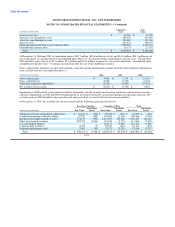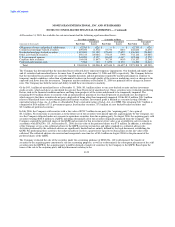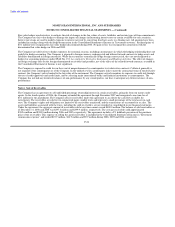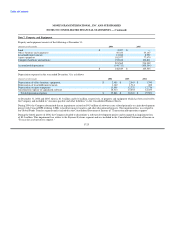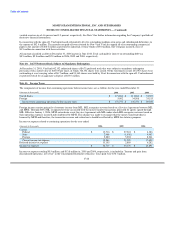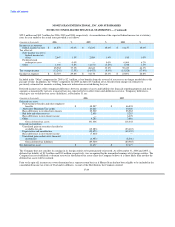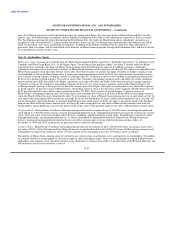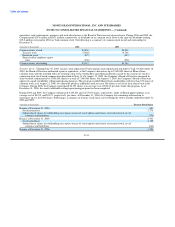MoneyGram 2006 Annual Report Download - page 80
Download and view the complete annual report
Please find page 80 of the 2006 MoneyGram annual report below. You can navigate through the pages in the report by either clicking on the pages listed below, or by using the keyword search tool below to find specific information within the annual report.
Table of Contents
MONEYGRAM INTERNATIONAL, INC. AND SUBSIDIARIES
NOTES TO CONSOLIDATED FINANCIAL STATEMENTS — (Continued)
QSPE, the Company determined that sale accounting was achieved upon transfer of the securities to the acquiring party and that the
Company was not a transferor of securities to the QSPE. The Company then evaluated the accounting guidance of FIN 46R to determine
whether the Company was required to consolidate the QSPE. As the Company does not have the unilateral ability to liquidate the QSPE or
to change the entity so that it no longer meets the requirements of a QSPE through either its ownership of the preferred shares or its
subsidiary's role as collateral advisor, the Company is not required to consolidate the QSPE.
Note 5. Derivative Financial Instruments
Derivative contracts are financial instruments such as forwards, futures, swaps or option contracts that derive their value from underlying
assets, reference rates, indices or a combination of these factors. A derivative contract generally represents future commitments to purchase
or sell financial instruments at specified terms on a specified date or to exchange currency or interest payment streams based on the contract
or notional amount. The Company uses derivative instruments primarily to manage exposures to fluctuations in interest rates and foreign
currency exchange rates.
Cash flow hedges use derivatives to offset the variability of expected future cash flows. Variability can arise in floating rate assets and
liabilities, from changes in interest rates or currency exchange rates or from certain types of forecasted transactions. The Company enters
into foreign currency forward contracts of generally less than 30 and 90 days to hedge forecasted foreign currency money transfer
transactions. The Company designates these currency forwards as cash flow hedges. If the forecasted transaction underlying the hedge is no
longer probable of occurring, any gain or loss recorded in equity is reclassified into earnings.
The Company has also entered into swap agreements to mitigate the effects on cash flows of interest rate fluctuations on variable rate debt
and commissions paid to financial institution customers of our Payment Systems segment. The agreements involve varying degrees of credit
and market risk in addition to amounts recognized in the financial statements. These swaps are designated as cash flow hedges. The swap
agreements are contracts to pay fixed and receive floating payments periodically over the lives of the agreements without the exchange of
the underlying notional amounts. The notional amounts of such agreements are used to measure amounts to be paid or received and do not
represent the amount of the exposure to credit loss. The amounts to be paid or received under the swap agreements are accrued in accordance
with the terms of the agreements and market interest rates.
The notional amount of the swap agreements totaled $2.6 billion and $2.7 billion at December 31, 2006 and 2005, respectively, with an
average fixed pay rate of 4.3 percent and 4.2 percent and an average variable receive rate 5.2 percent and 4.1 percent at December 31, 2006
and 2005, respectively. The variable rate portion of the swaps is generally based on Treasury bill, federal funds, or 6 month LIBOR. As the
swap payments are settled, the net difference between the fixed amount the Company pays and the variable amount the Company receives is
reflected in the Consolidated Statements of Income in "Investment commissions expense." The amount recognized in earnings due to
ineffectiveness of the cash flow hedges is not material for any year presented. The Company estimates that approximately $8.4 million (net
of tax) of the unrealized loss reflected in the "Accumulated other comprehensive income (loss)" component in the Consolidated Balance
Sheet as of December 31, 2006 will be reflected in the Consolidated Statement of Income in "Investment commissions expense" within the
next 12 months as the swap payments are settled. The agreements expire as follows:
(Amounts in thousands) Notional Amount
2007 $ 1,200,000
2008 100,000
2009 575,000
2010 335,000
Thereafter 397,000
$ 2,607,000
F-23



